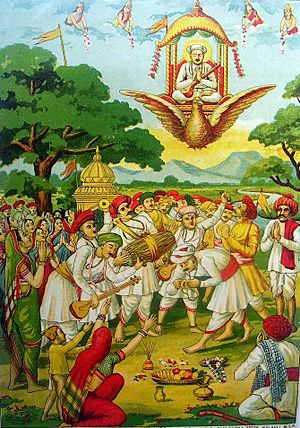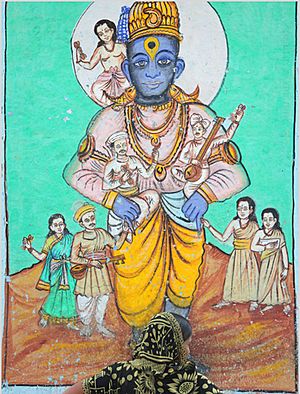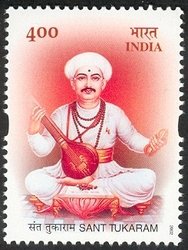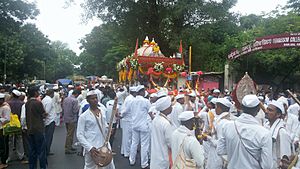Tukaram facts for kids
Quick facts for kids Sant Tukaramसंत तुकाराम |
|
|---|---|

Sant Tukaram Maharaj
|
|
| Birth Date | Either 1598 or 1608 Dehu,Pune Maharashtra, India |
| Died on | Either 1649 or 1650 in Dehu,Pune |
| Birth name | Tukaram Bolhoba Ambile |
Sant Tukaram Maharaj was a very important Hindu saint from the 17th century. He lived in Maharashtra, India. People often called him Tuka, Tukobaraya, or Tukoba.
He was a part of the Varkari tradition, which is a special group of people who worship the god Vitthal. This tradition focuses on personal devotion. Sant Tukaram Maharaj is famous for his devotional poems called Abhanga. He also led community worship with spiritual songs known as kirtan.
About Sant Tukaram
His Early Life
Tukaram was born in a village called Dehu, near Pune in Maharashtra, India. This was either in 1598 or 1608. His full name was Tukaram Bolhoba Ambile.
His parents were Kanakai and Bolhoba More. His family was involved in farming, trading, and lending money. Tukaram's parents were devoted followers of Vithoba, a form of the Hindu god Vishnu. Sadly, both his parents passed away when Tukaram was a teenager.
Tukaram's first wife was Rakhama Bai. They had a son named Santu. During a terrible famine in 1630–1632, both his wife and son died from hunger. These sad events and the widespread poverty deeply affected Tukaram. He spent a lot of time thinking and meditating in the Sahyadri hills. He later wrote that he had "discussions with my own self." Tukaram married again, and his second wife was Avalai Jija Bai.
His Later Life

He spent most of his later years in worship. He also led community singing prayers called kirtans and wrote his Abhanga poems.
Tukaram used his kirtans and abhangs to speak out against wrongdoings in society. He also spoke about problems in the social system. Because of this, some people opposed him. A man named Mambaji, who ran a religious center, bothered him a lot. Mambaji was jealous of the respect Tukaram received. He even hit Tukaram once. However, Mambaji later became a follower of Tukaram.
Tukaram passed away in 1649 or 1650. Some people believe he met Chatrapati Shivaji Maharaj, a famous leader who started the Maratha Empire. Historians say that Bhakti movement poets like Tukaram helped Shivaji rise to power.
His Ideas and Practices
Understanding Vedanta
In his poems, Tukaram often mentioned four other saints who greatly influenced him. These were Namdev, Dnyaneshwar, Kabir, and Eknath.
Tukaram's teachings are based on Vedanta, a Hindu philosophy. His poems show a belief that God is everywhere in the universe. For example, in one poem, he says that "the whole universe is filled by God." He believed that God is present in everything.
There has been some discussion about whether Tukaram followed the idea of one God (monism) or two separate things (dualism). Some of his poems seem to support one idea, while others support the other. This is partly because many copies of his poems exist, and they are not all exactly the same. Also, Tukaram did not write his poems down himself; others wrote them later from memory.
Tukaram did not like mechanical religious practices. He did not believe in rituals, sacrifices, or vows. Instead, he encouraged a direct and loving way of devotion called bhakti.
The Importance of Kirtan
Tukaram strongly supported kirtan. This is a type of group singing and dancing that expresses devotion. He believed kirtan was not just a way to learn about devotion, but it was devotion itself. According to Tukaram, the best thing about kirtan is that it helps both the person singing and others find a spiritual path.
Social Changes
Tukaram welcomed all people as his students and followers, no matter their gender or social background. One of his well-known followers was Bahina Bai, a Brahmin woman. She faced difficulties from her husband because she chose Tukaram as her teacher.
Tukaram taught that a person's social group or caste does not make them holy. He said that "castes do not matter, it is God's name that matters." He believed that anyone who loves God's name is truly a good person.
Tukaram's efforts helped bring people from different backgrounds together in the Varkari tradition. He was one of many non-Brahmin saints in this tradition. This shows how the Bhakti movement worked to include everyone.
His Writings

Tukaram wrote Abhanga poetry. This is a type of Marathi literature that has a rhythm and is simple to understand. It often mixes folk stories with deep spiritual ideas.
His writings are known for being informal and full of joy. He wrote in everyday language. In one poem, Tukaram humbly described himself as a "fool" who loved being alone. He said he worshipped Vitthal like his ancestors but felt he lacked their strong faith.
The Tukaram Gatha is a collection of his works in Marathi. It is believed to contain about 4,500 abhangas. These poems cover many human feelings and life experiences. Some are about his own life. They also discuss the choice between living a normal life with family and work, and wanting to leave everything for spiritual freedom.
How Authentic Are His Poems?
There are many different copies of the Tukaram Gatha. Scholars are not sure if all the poems are truly written by Tukaram. The poems were written down much later by others who remembered them. This makes it hard to know if the modern collection truly shows what Tukaram thought and said.
Books and Translations
Many books have been written about Tukaram. In the 18th century, a writer named Mahipati included Tukaram in his collection of Bhakti movement saints' lives.
Later, many of Tukaram's poems were translated into English. For example, Dilip Chitre translated his writings into a book called Says Tuka. This book won an award in 1994.
His Impact
Influence in Maharashtra
Tukaram's abhangs are very popular in Maharashtra. They have become a big part of the state's culture. Many people, including poets and followers, study his poems. They are especially popular in rural areas.
Tukaram was a devoted follower of Vithoba (Vitthala), a form of God Vishnu. His writings, along with those of saints like Dnyandev, Namdev, and Eknath, helped spread the Varkari tradition across India.
Historians say that Tukaram's legacy helped Marathi-speaking people feel a strong shared identity. During times of conflict, his work helped unite the Marathas.
Influence on Mahatma Gandhi
Mahatma Gandhi, a famous leader in India, read and translated Tukaram's poetry. He did this while he was in jail during his non-violent movement against the British.
Sant Tukaram also greatly influenced K. B. Hedgewar, who founded a major Indian organization. Hedgewar often used Tukaram's quotes on his letters. One quote said, "Compassion is not only the welfare of all living beings, but also includes protecting them from harm's way."
Places Connected to Tukaram
There are several important places in Dehu that are linked to Tukaram:
- Tukaram Maharaj Janm Sthan Temple, Dehu: This is the place where Tukaram was born. A temple was built here later.
- Sant Tukaram Vaikunthstan Temple, Dehu: This is where Tukaram is believed to have gone to Vaikuntha (the home of God). There is a beautiful riverbank behind this temple along the Indrayani river.
- Sant Tukaram Maharaj Gatha Mandir, Dehu: This is a large, modern building with a big statue of Tukaram. About 4,000 of his abhangs are carved on its walls.
Movies and Popular Culture
Many Indian films have been made about Sant Tukaram in different languages. Some of these include:
- Tukaram (1921) – a silent film.
- Sant Tukaram (1936) – This movie was very popular and played for a year in Mumbai. Many people traveled far to see it.
- Thukkaram (1938) in Tamil.
- Santha Thukaram (1963) in Kannada.
- Bhakta Tukaram (1973) in Telugu.
- Tukaram (2012) in Marathi.
Tukaram's life was also featured in the 68th issue of Amar Chitra Katha, a popular Indian comic book series. In 2002, the Indian government released a 100-rupee silver coin to honor him.
See also
- Bhakti movement
- Pandharpur Wari – a large annual pilgrimage in Maharashtra that includes a special procession for Tukaram.
- Vitthal Temple, Pandharpur
- Sant Dnyaneshwar





